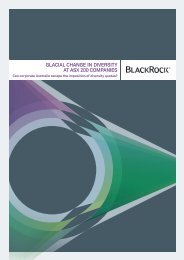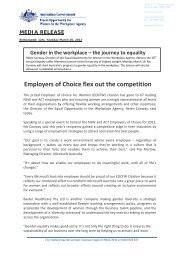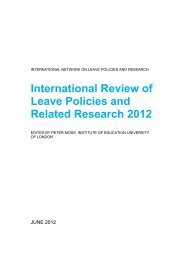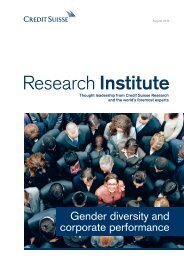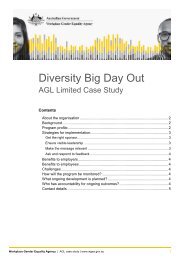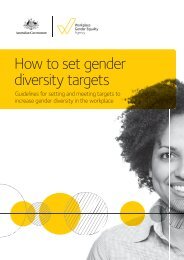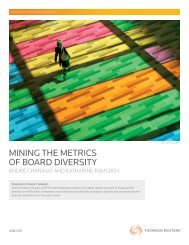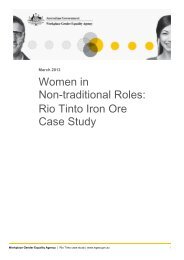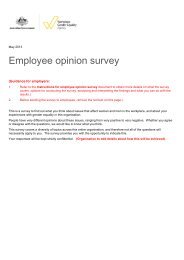Women in NSW 2012 - The Workplace Gender Equality Agency
Women in NSW 2012 - The Workplace Gender Equality Agency
Women in NSW 2012 - The Workplace Gender Equality Agency
Create successful ePaper yourself
Turn your PDF publications into a flip-book with our unique Google optimized e-Paper software.
3.2 <strong>Women</strong> tak<strong>in</strong>g part <strong>in</strong> screen<strong>in</strong>g activitiesBiennial screen<strong>in</strong>g rate – women <strong>in</strong> the target groups for breast cancer and cervical cancerCurrent position<strong>The</strong> direction of changeover timeDiscussionOf <strong>NSW</strong> women aged 50 to 69 years, 53 percent were screened forbreast cancer <strong>in</strong> 2009-10.Of <strong>NSW</strong> women aged 20 to 69 years, 56 percent were screened forcervical cancer <strong>in</strong> 2009-10.Breast cancer: the proportion of women aged 50 to 69 years screenedreached a high po<strong>in</strong>t of 56 percent <strong>in</strong> 2006-07, then decreased <strong>in</strong>subsequent years.Cervical cancer: the proportion of women aged 20 to 69 years screenedreached a high po<strong>in</strong>t of 59 percent at the end of the 1990s and <strong>in</strong> the early2000s, then fell off slightly.<strong>The</strong> <strong>in</strong>cidence of new cases of breast cancer has been <strong>in</strong>creas<strong>in</strong>g, but thedeath rate has been decreas<strong>in</strong>g.<strong>The</strong> number of new cases and the death rate from cervical cancer have bothsteadily decreased <strong>in</strong> <strong>NSW</strong> <strong>in</strong> the last two decades.Screen<strong>in</strong>g is considered to be an effective population-based method for reduc<strong>in</strong>g mortality and morbidity related tocancer, by detect<strong>in</strong>g it early. <strong>NSW</strong> Health aims to screen, on a two-yearly basis, 50 to 69 year old women for breastcancer and 20 to 69 year old women for cervical cancer. Breast cancer is the most common women’s cancer <strong>in</strong> <strong>NSW</strong>and cervical cancer is the 14th most common.Year collected: 2009-10 and earlier years.Data source: BreastScreen <strong>NSW</strong> and Australian Institute of Health and Welfare (AIHW) analysis of state and territory cervical cytology register data.More <strong>in</strong>formation is available at www.healthstats.nsw.gov.au and www.aihw.gov.au<strong>The</strong> <strong>in</strong>cidence of new cases of breastcancer has been <strong>in</strong>creas<strong>in</strong>g, but the deathrate has been decreas<strong>in</strong>g.<strong>The</strong> number of new cases and the deathrate from cervical cancer have bothsteadily decreased <strong>in</strong> <strong>NSW</strong> <strong>in</strong> the lasttwo decades.WOMEN IN <strong>NSW</strong> <strong>2012</strong> | HEALTH AND WELLBEING25



